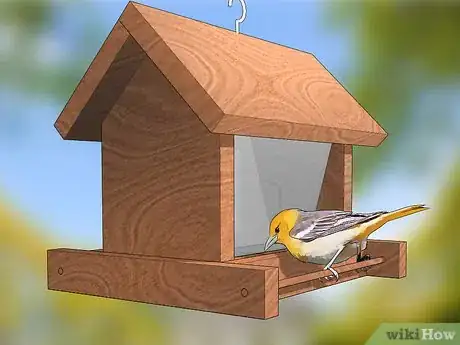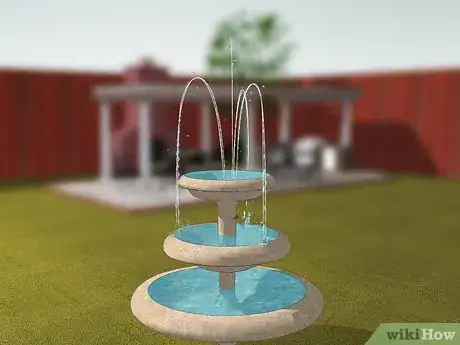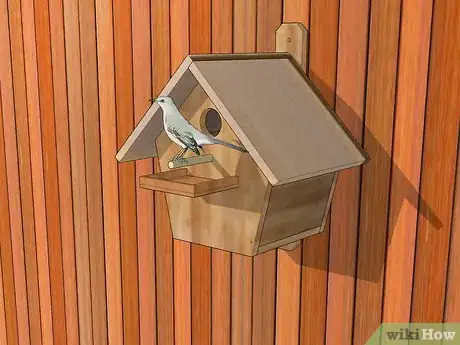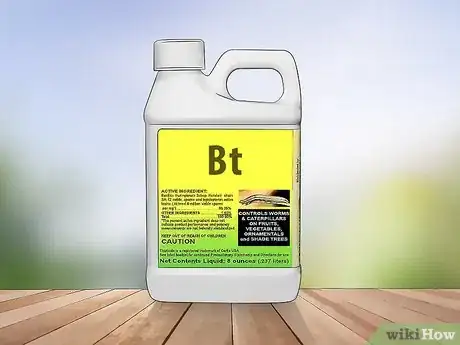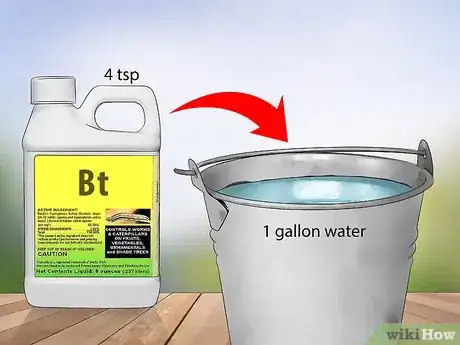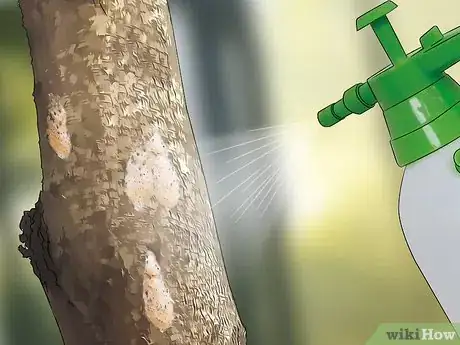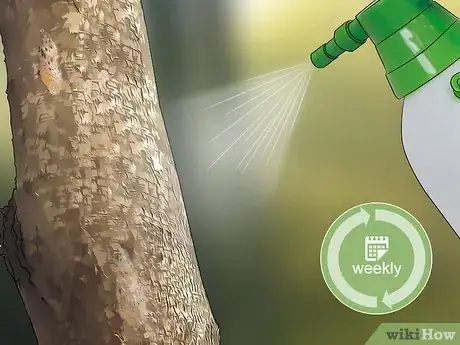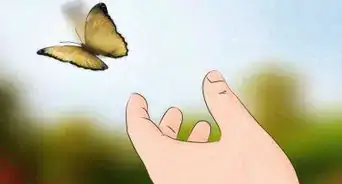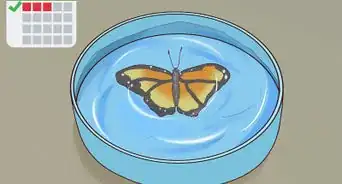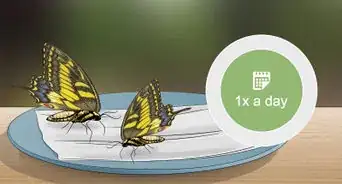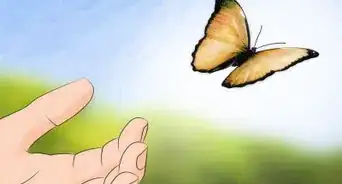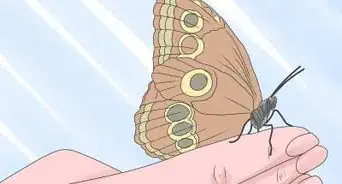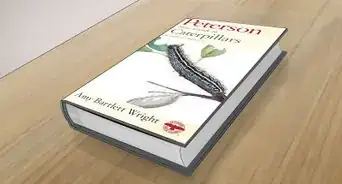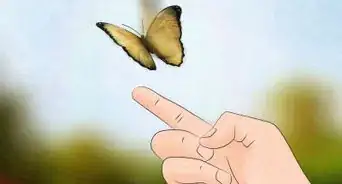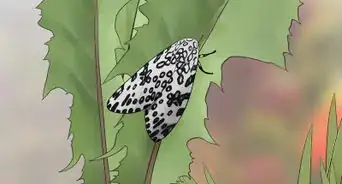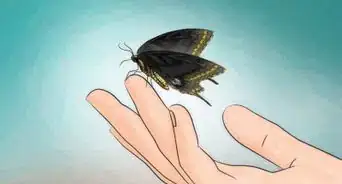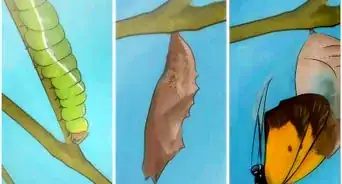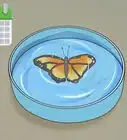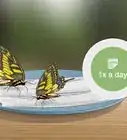This article was co-authored by wikiHow Staff. Our trained team of editors and researchers validate articles for accuracy and comprehensiveness. wikiHow's Content Management Team carefully monitors the work from our editorial staff to ensure that each article is backed by trusted research and meets our high quality standards.
There are 7 references cited in this article, which can be found at the bottom of the page.
This article has been viewed 38,944 times.
Learn more...
Gypsy moths (now renamed spongy moths) are destructive pests in areas with lots of trees, and they can completely strip your trees of leaves if left untreated. Their most common hosts are oak and aspen trees. Luckily, the solutions to a spongy moth infestation are simple: attract more birds, which are a natural predator of the spongy moth; keep your yard clean, as rotting wood and unclean surfaces are great spots for moths to lay eggs; and spray your trees with organic pesticide to kill off spongy moth caterpillars directly.
Steps
Attracting More Birds
-
1Put a bird feeder in your lawn. Bringing birds into your yard will help you control spongy moths, as birds tend to spot and eat spongy moth larvae while searching for seeds. Hang a bird feeder in your lawn and keep it full of bird feed to naturally control the spongy moths in your area.
- Birds that typically feed on spongy moths are yellow- and black-billed cuckoos, blue jays, orioles, rufous-side towhees, and black-capped chickadees.
- Black-oil sunflower seeds are a great feed option as they are popular with many types of birds.[1] Most mid- to high-quality bird seeds will come with a list of types of birds that the type of seed attracts.
-
2Attract birds to your yard with a small fountain. Birds will stop into your yard if they know you have water available. Purchase a fountain and small water pump from an outdoor or hardware store, and assemble it in your yard according to the instructions.[2]
- If you don’t have a fountain, a running hose dripping into a small reservoir will make enough noise to draw birds to your yard—just make sure it has a ledge for the birds to rest on while they drink. You could use a gardening pot or a kitchen saucepan with a diameter of at least 4 inches (10 cm).
- Elevate the makeshift fountain on a stool, chair, or cinder block. If it's left directly on the ground, insects will make their way into the fountain.
Advertisement -
3Install a birdhouse to make your yard a resting place for birds. Birds are more likely to return to sites where they can nest. Purchase a birdhouse and place it in your yard by drilling it to a free-standing wood or PVC pole.[3]
- If you don't have a free-standing pole in your yard, you can attach it to a tree by stringing bungee cords through the birdhouse and around the tree.
- Chickadees, a primary predator of spongy moths, like to nest in houses that are 4–8 ft (1.2–2.4 m) off the ground and hidden in a stand of small trees or shrubs.
Keeping Your Yard Clean
-
1Get rid of dead wood, branches, and stumps. Throughout the year, burn or throw away any dead wood that's sitting around in your yard. Gypsy moths deposit their eggs into dead wood, so the less of it you have in your yard, the better.[4]
- Be sure to check for dead wood on your trees as well. Dead branches will be leafless.
-
2Cover woodpiles during summer and fall. When you’re not using your firewood, don’t let spongy moths have access to it; purchase a tarp to cover your woodpiles. Spongy moths lay egg masses in the crevices between pieces of wood, making them hard to find and destroy.[5]
- Check for egg masses before covering your wood. If you spot an egg mass, destroy the eggs and then cover the wood.
-
3Identify and kill egg masses when you see them. Turn up old wood and detritus where spongy moths are a problem to look for their eggs. You’ll spot them by their 1–2 in (2.5–5.1 cm) size, their teardrop shape, and their yellow-brown color (similar to that of a manilla envelope). Scrape the egg masses into a plastic container and microwave them on high for 2 minutes, then throw them in the trash.[6]
- Alternatively, put the egg masses into a container and cover them with soapy water. Then, throw out the container.
- Don’t just scrape them onto the ground, as egg masses can burrow into the ground and still hatch.
- Wear gloves when you’re hunting for egg masses, as the hairs in their lining can irritate your skin.
Using Pesticides to Kill Caterpillars
-
1Buy bacillus thuringiensis from a garden or hardware store. Bacillus thuringiensis (often called “Bt”) is a soil-dwelling bacterium that can be used as a pesticide. It’s often marketed as “Dipel” or “Thuricide.” You’ll also need to buy a spray bottle or a pump sprayer.[7]
- Bt is nontoxic to humans and animals. Some varieties are certified organic: look for the Organic Materials Research Institute (OMRI) certification on the label.
-
2Wear gloves and goggles while working with Bt. While Bt is nontoxic to humans, it can irritate your eyes. Put on some gardening gloves and eye protection while you're working with Bt to avoid the chances of Bt getting in your eyes. To avoid getting Bt on others, make sure that all people and animals stay out of the area while you're applying Bt.[8]
- In addition, always wash your hands with soap and water after handling Bt.
-
3Mix 4 tsp (20 ml) of Bt with 1 US gal (3.8 l) of water. The Bt available in stores is typically concentrated, so you’ll need to mix it with water to avoid damage to your plants; even an organic product can be dangerous if it’s too concentrated. Pour the mixture of Bt and water into your spraying canister.[9]
- Don’t store this diluted mix for more than 12 hours; to dispose of it, pour it into a secure container and put it in the trash.
-
4Spray the Bt onto areas full of caterpillars or egg sacks. Spray the mixture of Bt and water onto your plants, trees, and any other areas where spongy moths are a problem. You'll find these areas by looking for the small caterpillars or yellow and brown egg sacks on trees and rotted wood. Cover the areas with the Bt mixture, but not so much that the mixture drips. Cover the tops and bottoms of leaves with a few sprays.[10]
- Apply the treatment in the afternoon or evening. Sun degrades Bt, so by waiting until the sun is going down, you can ensure that the Bt is working at its strongest level. The hottest part of the day is usually around 3 pm, so be sure to wait 2-4 hours before applying the treatment.
- Bt kills spongy moth caterpillars when it’s ingested, so ideally, you want to get it onto whatever they’re going to eat: in this case, your plants and trees. Bt is not necessarily effective at killing mature spongy moths.[11]
-
5Repeat the treatment after a week. Bt needs a little bit of time to work. Once a week has passed, apply another treatment. If, after 2 weeks, an infestation appears again, apply a third treatment. Always wait at least a week; you don’t want to help the spongy moths build a resistance to the Bt.[12]
- Bt will kill all leaf-eating caterpillars, including monarch butterflies. You may need to plant milkweed after the Bt treatment has run its course to attract more monarchs to your yard, if you want them.
- If you attract monarchs prematurely (before the Bt treatments have finished), you'll end up killing the monarchs too.
Things You'll Need
- Bird feeder or bird house
- Seeds
- Small fountain
- Tarp for woodpiles
- Bt
- Spray canister
- Safety gloves and goggles
References
- ↑ http://blog.nwf.org/2011/01/for-beginners-four-cant-miss-ways-to-attract-birds-to-your-yard-or-deck/
- ↑ http://blog.nwf.org/2011/01/for-beginners-four-cant-miss-ways-to-attract-birds-to-your-yard-or-deck/
- ↑ http://blog.nwf.org/2011/01/for-beginners-four-cant-miss-ways-to-attract-birds-to-your-yard-or-deck/
- ↑ https://extension.entm.purdue.edu/GM/index.php?page=home_streamline
- ↑ https://extension.entm.purdue.edu/GM/index.php?page=home_streamline
- ↑ https://learningstore.uwex.edu/Assets/pdfs/FR-171A.pdf
- ↑ https://plantcaretoday.com/bacillus-thuringiensis.html
- ↑ https://southernag.com/wp-content/uploads/2014/06/ThuricideBT-Caterpillar-Control-1.pdf
- ↑ https://www.biconet.com/biocontrol/infosheets/thuricideLabel.pdf
About This Article
To get rid of gypsy moths, try putting up a bird feeder in your lawn, since birds tend to eat gypsy moth larvae when they’re looking for seeds. Alternatively, attract birds by putting a small fountain in your yard. You should also burn or dispose of dead wood, like twigs and stumps, since gypsy moths lay their eggs in dead wood. Additionally, cover your wood piles with a tarpaulin so the moths can’t lay their eggs in between the pieces of wood. If you want to use a pesticide, spray a mixture of bacillus thuringiensis and water onto the areas with caterpillars or eggs. For tips on how to kill large masses of gypsy moth eggs, read on!
